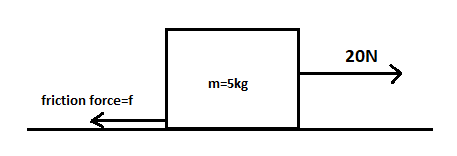
A force of \[20{\rm{ }}N\] is applied on a body of mass \[5{\rm{ }}kg\] resting on a horizontal plane. The body gains kinetic energy of \[10{\rm{ }}joules\] after it moves a distance of \[2{\rm{ }}m\]. The frictional force is:
1. \[10N\]
2. \[15N\]
3. \[20N\]
4. \[30N\]
Answer
220.2k+ views
Hint: To solve this question we should first start with the free body diagram so that will understand all kinds of forces acting on it. In this question, we will use the concept of kinetic energy to find the velocity of the block.
Formula Used:
\[K.E. = \dfrac{1}{2}m{v^2}\]
\[{v^2} = {u^2} + 2as\]
\[f = F - ma\]
Complete answer:
Given Data:
Force \[ = 20N\]
Mass of the body \[ = 5kg\]
Kinetic energy gained by the body on the horizontal surface after moving \[2{\rm{ }}m\] \[ = 10J\]
Now, let us draw a free body diagram for a better understanding of the concept,

So, from the above figure, we can see that both forces applied and the force of friction are opposite to each other in direction as shown in the above figure.
Now, we have to calculate frictional force from the above-given data:
Using the formula for K.E. we get
\[K.E. = \dfrac{1}{2}m{v^2}\]
\[ \Rightarrow 10J = \dfrac{1}{2} \times 5kg \times {v^2}\]
\[ \Rightarrow {v^2} = 4\]
\[\therefore v = 2m/s\]
For finding out frictional force we need the velocity of the box, now for finding acceleration we have to use a kinematic equation and that is given by:
\[{v^2} = {u^2} + 2as\]
\[u\] is the initial velocity and it is zero since the box was at rest, \[s\] is the distance the box is pushed i.e., \[2{\rm{ }}m\]
Therefore, after putting all the values in the above equation, we get
\[ \Rightarrow 4 = 0 + 2a(2)\]
\[ \Rightarrow a = 1m/{s^2}\]
Now, we have a formula for the frictional force
\[f = F - ma\]
\[ \Rightarrow f = 20N - 5kg \times 1m/{s^2}\]
\[ \Rightarrow f = 20N - 5N\]
\[\therefore f = 15N\]
Thus, the frictional force acting on the box is \[15N\]
Therefore, the right answer is option 2.
Note: We should remember that we can not always use the kinetic energy formula to find the velocity of the block. In this problem we had given the value of the kinetic energy thus we can use the formula to attain the required value of velocity.
Formula Used:
\[K.E. = \dfrac{1}{2}m{v^2}\]
\[{v^2} = {u^2} + 2as\]
\[f = F - ma\]
Complete answer:
Given Data:
Force \[ = 20N\]
Mass of the body \[ = 5kg\]
Kinetic energy gained by the body on the horizontal surface after moving \[2{\rm{ }}m\] \[ = 10J\]
Now, let us draw a free body diagram for a better understanding of the concept,

So, from the above figure, we can see that both forces applied and the force of friction are opposite to each other in direction as shown in the above figure.
Now, we have to calculate frictional force from the above-given data:
Using the formula for K.E. we get
\[K.E. = \dfrac{1}{2}m{v^2}\]
\[ \Rightarrow 10J = \dfrac{1}{2} \times 5kg \times {v^2}\]
\[ \Rightarrow {v^2} = 4\]
\[\therefore v = 2m/s\]
For finding out frictional force we need the velocity of the box, now for finding acceleration we have to use a kinematic equation and that is given by:
\[{v^2} = {u^2} + 2as\]
\[u\] is the initial velocity and it is zero since the box was at rest, \[s\] is the distance the box is pushed i.e., \[2{\rm{ }}m\]
Therefore, after putting all the values in the above equation, we get
\[ \Rightarrow 4 = 0 + 2a(2)\]
\[ \Rightarrow a = 1m/{s^2}\]
Now, we have a formula for the frictional force
\[f = F - ma\]
\[ \Rightarrow f = 20N - 5kg \times 1m/{s^2}\]
\[ \Rightarrow f = 20N - 5N\]
\[\therefore f = 15N\]
Thus, the frictional force acting on the box is \[15N\]
Therefore, the right answer is option 2.
Note: We should remember that we can not always use the kinetic energy formula to find the velocity of the block. In this problem we had given the value of the kinetic energy thus we can use the formula to attain the required value of velocity.
Recently Updated Pages
Electricity and Magnetism Explained: Key Concepts & Applications

JEE Energetics Important Concepts and Tips for Exam Preparation

JEE Isolation, Preparation and Properties of Non-metals Important Concepts and Tips for Exam Preparation

JEE Main 2021 July 25 Shift 1 Question Paper with Answer Key

JEE Main 2021 July 22 Shift 2 Question Paper with Answer Key

States of Matter Chapter For JEE Main Chemistry

Trending doubts
JEE Main 2026: Application Form Open, Exam Dates, Syllabus, Eligibility & Question Papers

Understanding Uniform Acceleration in Physics

Derivation of Equation of Trajectory Explained for Students

Hybridisation in Chemistry – Concept, Types & Applications

Understanding the Angle of Deviation in a Prism

How to Convert a Galvanometer into an Ammeter or Voltmeter

Other Pages
Thermodynamics Class 11 Physics Chapter 11 CBSE Notes - 2025-26

JEE Advanced Marks vs Ranks 2025: Understanding Category-wise Qualifying Marks and Previous Year Cut-offs

Units And Measurements Class 11 Physics Chapter 1 CBSE Notes - 2025-26

NCERT Solutions For Class 11 Physics Chapter 8 Mechanical Properties Of Solids

Motion in a Straight Line Class 11 Physics Chapter 2 CBSE Notes - 2025-26

NCERT Solutions for Class 11 Physics Chapter 7 Gravitation 2025-26




